Grooming in Cats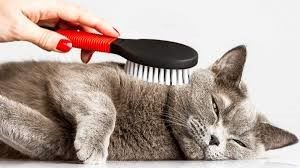
By Shelly Chadwick & TJ Welsh
When you hear the word “grooming” what pops into your mind? Dogs in the show ring? That pristine white Bichon Frise? The beautiful long flowing hair on that Rough Coated Collie? What if we told you that cats, yes cats should pop into your head too? No, I haven’t spent too much time with the “nip” if you know what I mean!
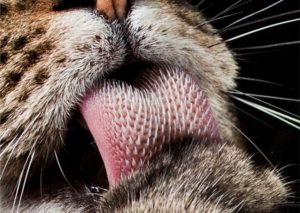 Who needs thumbs?
Who needs thumbs?
Cats groom themselves, don’t they? Our feline friends are known for their fastidious nature and almost constant grooming but just like dogs they need our help. How do they accomplish that without thumbs? Cats have highly specialized tongues that are covered in tiny “hooks” called papillae. The papillae are backward facing spines that are hollow and scoop shaped which allows the spines to hold saliva. Every time a cat licks itself, these spines brush the coat and help remove dirt and loose hair. Researcher David Hu, a bioengineer at Georgia Tech, along with National Geographic took high speed videos showing “that the papillae actually rotate when the cat’s tongue encountered knots in the fur to let the spike probe even deeper into the knot to work it loose.”
Why is my cat not grooming?
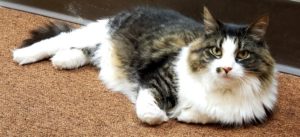 In most cases, cats can take care of grooming and staying knot free themselves. But what happens when they can’t groom effectively? Several health issues can impede a cats ability to groom. Older cats may have developed arthritis and therefore lose the flexibility needed to reach certain areas. Weight can also be a factor in grooming anything other than the front paws, head, and face. Cats with dental disease may also be less likely to groom due to oral pain. Oral tumors could also be a source of ineffective grooming or even cause a foul odor that seems like it’s coming from your pet’s coat.
In most cases, cats can take care of grooming and staying knot free themselves. But what happens when they can’t groom effectively? Several health issues can impede a cats ability to groom. Older cats may have developed arthritis and therefore lose the flexibility needed to reach certain areas. Weight can also be a factor in grooming anything other than the front paws, head, and face. Cats with dental disease may also be less likely to groom due to oral pain. Oral tumors could also be a source of ineffective grooming or even cause a foul odor that seems like it’s coming from your pet’s coat.
A non-health related reason for knotted or matted coats is hair length and type. Domestic house cats tend to shed all year round due to living in homes with air conditioning and heat. Cats with medium or long coats may need a little extra help from you because they have two types of fur on their bodies: an outer protective coat and an undercoat. When longer haired cats shed, the undercoat can get tangled in the outer coat. The areas that usually get knotted first are the areas with the most movement such as between the front and back legs, around the neck, and around the collar.
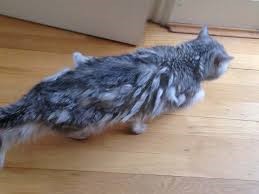 Mats and knots can be very uncomfortable for your cat. They can cause or hide skin infections or wounds. To prevent this from happening, you should run your hands all over your cat’s body at least once a day, being sure to check the areas that are prone to knots. You can also add Vitamin E and Omega 3 fatty acids which can help grow a healthy coat. Daily brushing is a great way to remove extra hair, deter mats form forming, and even help prevent hairballs. Some cases of matting may get so severe that they can only be removed under anesthesia with electric clippers.
Mats and knots can be very uncomfortable for your cat. They can cause or hide skin infections or wounds. To prevent this from happening, you should run your hands all over your cat’s body at least once a day, being sure to check the areas that are prone to knots. You can also add Vitamin E and Omega 3 fatty acids which can help grow a healthy coat. Daily brushing is a great way to remove extra hair, deter mats form forming, and even help prevent hairballs. Some cases of matting may get so severe that they can only be removed under anesthesia with electric clippers.
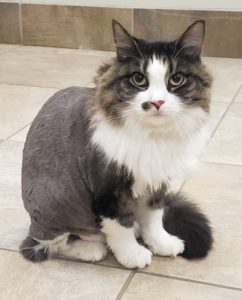 So pretty – KNOT!?!
So pretty – KNOT!?!
So what if you have done everything to prevent knotting/matting and yet you still find a knot. What now!? Please don’t attempt to cut it out with scissors! Cats have very thin skin that can be lacerated quite easily. You can try to brush out the mat gently with a brush or comb, take your kitty to a professional groomer, or bring your pet to their veterinarian.
If your cat has a sudden change in behavior, grooming habits or activity level you should seek out advice from your veterinarian to rule out any possible health complications that may be causing an issue. When brushing, take note of the amount of hair that is shed out, if there is any dirt present, or if there any areas where your cat may be uncomfortable with you touching.
Tips for getting your kitty used to being brushed
- Start slowly! Kitty will be more receptive to a short brushing session. Make sure you stop brushing before kitty gets stressed.
- Always brush the coat in the direction in which it grows.
- For longer haired cats start with a wide comb and once you can run that through with no snags follow up with a fine-toothed comb to make sure you didn’t miss anything.
- Use treats! Giving your baby some tasty treats during the grooming session will help your cat learn to like being brushed.

